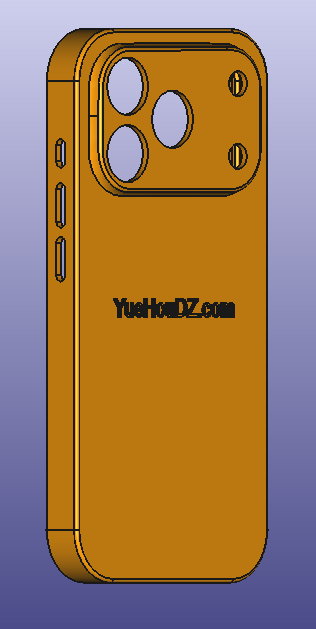With the release of the iPhone 17 Pro, many small businesses and creative designers are eager to turn their ideas into unique silicone phone cases. In this article, we document the technical design process of a basic silicone case, highlight key considerations, and share creative ideas for those who want to stand out in the market.
1. Reference Dimensions of iPhone 17 Pro
Accurate measurements of the device are the foundation for reliable case design:
- Length: 150 mm (5.91 in)
- Width: 71.9 mm (2.83 in)
- Thickness (without camera bump): 8.75 mm (0.34 in)
- Thickness (with camera bump, measured): 12.35 mm
2. Basic Silicone Case Design Specifications
A simple protective sleeve designed for the iPhone 17 Pro typically follows these parameters:
- Wall Thickness: 2 mm (thin enough to avoid bulkiness while ensuring protection).
- Corner Fillet (R): ≥ 0.5 mm.
- Screen Overlap: 2 mm inward extension, wrapping slightly over the screen edge.
- Silicone Hardness: 75° Shore A.
Lower hardness may lead to poor grip, where the 2 mm overlap cannot hold the phone securely. This results in a functional, minimalist silicone case that many users prefer.
3. Creative Design Extensions
While a bare silicone shell serves its protective purpose, creative features add value and differentiation:
- Texture & Patterns: Add wave lines or geometric grooves on the back to improve both aesthetics and grip.
- Cartoon & Cute Designs: For younger users, consider incorporating animal shapes, such as rabbit ears or cat tails, extending from the edges.
- Color Variations: Multi-color compression molding allows for gradient or dual-tone effects.
- Functional Add-ons: Incorporate card slots, mirror compartments, or lanyard holes for added practicality.
4. From CAD to Molding
To assist with design iterations, a 3D STP reference model can be provided. This model enables modifications to dimensions, textures, or decorative elements before manufacturing.




Here are the links to download the 3D models: iPhone 17 Pro Silicone Protective Case 3D Model
When moving to production, the process involves:
- Compression Molding and Vulcanization: Raw silicone is placed into a mold cavity, then cured under high temperature and pressure to form the final case.
- Surface Finishing: Optional polishing, texture etching, or printing to achieve the desired effect.
⚠️ Note: Always verify design dimensions against the actual iPhone 17 Pro device before tooling. The reference model is for design inspiration only.
Conclusion
Designing a silicone case for the iPhone 17 Pro requires both technical accuracy and creative thinking. Through precise CAD modeling, careful parameter setting, and professional compression molding with vulcanization, designers can transform ideas into high-quality products ready for the market.